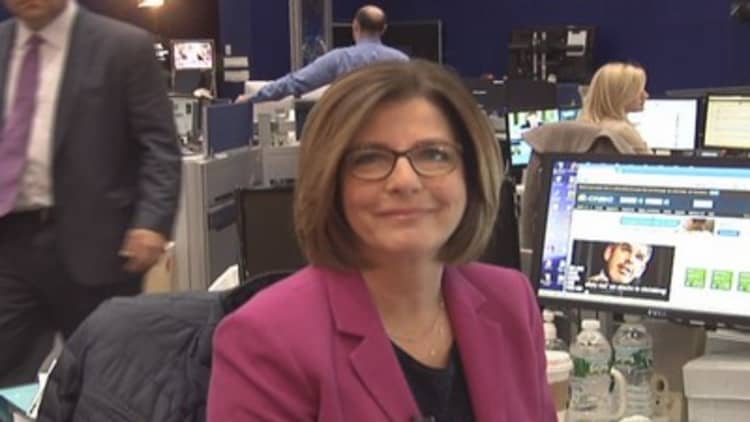The "C" class—stocks viewed as the lowest quality—has been teaching the rest of the market a lesson this year, leading the way with oversized gains.
But that could end as the Fed starts to slow down its bond buying program, expected in the next couple of months, and some strategists see a rotation coming into higher-quality, steadier earners.
"We've basically been in a market that's had a 'risk on' appetite. The market's up strong. It's driven by the fact interest rates remain low. The Fed continues to stimulate the market," said Chris Sunderland, institutional portfolio manager at Eaton Vance. "The lower-quality small-cap companies have pretty much led this market since March 2009, really since rates have been cut to zero."
S&P Capital IQ actually rates the companies of the with letter grades on the quality of how consistently companies raised earnings and dividends in each of the last 10 years. The average grade is "B+."
Those stocks with the lowest quality profile are graded "C," and they have seen average gains this year of 54 percent, as of the end of October. That compares to the just 18 percent underperformance of the highest quality, honors class, the "A+" names that always show earnings gains and consistently raise their dividends. The S&P 500, in the same time frame, was up 25.3 percent.
(Read more: Time to hedge against bubbles)
The "C" class is very small—less than a dozen names—but it parallels a portion of the broader market that has outperformed, like the momentum names and small caps.

"The catalyst for that to change would be when we enter a down market, have a correction or a down market period. That's a situation where high quality outperforms low quality. If you have a period of rising volatility, which would happen if the Fed started to taper, there's a brief period where the high quality starts to outperform. It's like a flight to safety," Sunderland said.
Sunderland expects to see the leadership pass to higher-quality names sometime in the first half of 2014. The Fed said it would likely decide to taper its asset purchase program at one of the next few meetings.
Sam Stovall, chief equity strategist at S&P Capital IQ, also expects to see a rotation. "The stock market cycle and the economic cycle are maturing, and as a result the Fed is looking to remove some of the stimulus, and as a result companies then have to advance on their own merits," he said.
Some of the companies in the "C" class are Salesforce.com, up 28.2 percent year-to-date; Regeneron up 63.3 percent; and Micron Technology, up 208 percent.
Most companies in the S&P 500 are average, "B " rated, and that group gained 23.6 percent through Oct. 31. Those names include Apple (down 3.1 percent year-to-date); Google (up 45 percent); Bristol-Myers (up 59 percent); Amgen(up 31 percent); Goldman Sachs (up 30 percent); American Express (up 45 percent); Boeing (up 77 percent); andCisco (up 8.7 percent).
(Read more: Superbear Marc Faber sees market opportunities)
The true high-quality names in the "A " class includes Coca-Cola (up 11.2 percent); Procter and Gamble (up 24.8 percent); Johnson and Johnson (up 35 percent); and Exxon, up 10 percent.
"Quality ranks is an important ingredient. It's like the chicken stock factor," in soup, said Mike Thompson, head of global market intelligence at S&P. High quality-rated names are one element in a portfolio. "It's a factor that does not really generate alpha. What it does is it protects you from down markets."
Sunderland said the shift to higher-quality large caps would also come as the global economy improves. Many smaller-cap names have only domestic exposure, and the U.S. has fared better than Europe and the emerging world.
"It's not going to happen with the snap of the fingers, but it's going to happen gradually. I can see a few things causing that in the next three to six months. One of the main factors is what's going on with the Fed, but both monetary and fiscal stimulus. As that starts to wane that's going to be benefit high-quality stocks at the expense of the lower quality," he said.
James Paulsen, chief investment strategist at Wells Capital Management, said he expects the stock market to be much more volatile next year, rising to as high as 2,000 on the S&P 500, before giving back some gains, and ending flattish for the year. "I think it will be a year of a big trade. You're going to have to change your ponies," he said.
Paulsen said he expects the economy to improve and monetary velocity to pick up, forcing the Fed to pull back on stimulus.
But he would still look for outperformance from some companies that might fall into the lower-quality tier, where earnings are uneven but growth is higher.
(Read more: There's a long way to go before Fed raises rates)
"One of the areas I might like best could be the materials. If we have a velocity pickup, materials might do better. When I look at next year, I'm looking at a 4 percent 10 year. One market that might be up is commodities, so materials stocks might do better," Paulsen said.
Stovall said over time, the high-quality names have outperformed. If measured from Dec. 31, 1999, through the end of October, the cumulative total return for the S&P 500 was 55 percent, versus the cumulative total return of the high-quality index, of 164 percent. The SPHQ, S&P High Quality ETF is up 27 percent, year-to-date, close to the 25.7 percent gain the S&P 500.
—By CNBC's Patti Domm. Follow here on Twitter @pattidomm.


